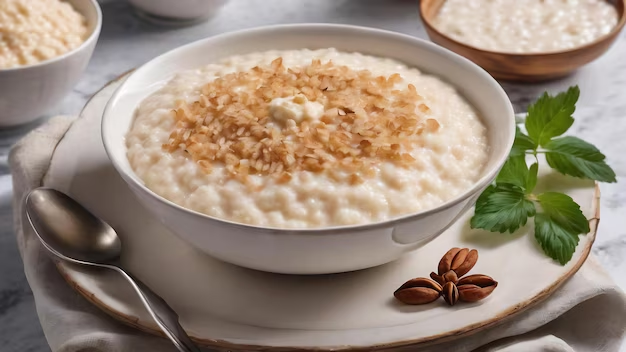Rice pudding, a comfort food enjoyed by many, often evokes nostalgic memories and provides a sense of warmth. But as with many beloved desserts, questions about its health benefits and nutritional value often arise. Is rice pudding healthy for you? In this comprehensive article, we will explore whether rice pudding is healthy, examining its ingredients, nutritional profile, potential health benefits, and drawbacks. By the end, you’ll have a clear understanding of how rice pudding fits into a balanced diet and whether it can be part of a healthy lifestyle.
For those who enjoy other comforting dishes, you might also like our Honey Pepper Chicken with Creamy Macaroni & Cheese, which combines indulgence with satisfying flavors.
Is Rice Pudding Healthy for You? Understanding the Nutritional Profile
Key Ingredients and Their Nutritional Impact
Rice pudding’s primary ingredients include rice, milk, sweeteners, and sometimes eggs and flavorings like cinnamon or vanilla. Each component plays a role in determining the dessert’s overall nutritional value. So, is rice pudding healthy for you when considering these ingredients?
Rice:
- Carbohydrates: Rice is a rich source of carbohydrates, providing energy and aiding in bodily functions.
- Fiber: Depending on the type of rice used, the fiber content can vary. Brown rice offers more fiber compared to white rice, promoting digestive health.
Milk:
- Calcium and Vitamin D: Milk is an excellent source of calcium and vitamin D, essential for bone health.
- Protein: The protein in milk supports muscle growth and repair.
- Fat Content: Whole milk adds creaminess but also increases the fat content. Skim or low-fat milk reduces calories but maintains most nutritional benefits.
Sweeteners:
- Sugar: Traditional recipes often use white or brown sugar, contributing to the calorie count but also offering quick energy.
- Natural Alternatives: Honey, maple syrup, or stevia can be used to reduce refined sugar intake and add unique flavors.
For a dessert that also balances indulgence with nutritional benefits, explore our Smores Crunchwraps, which offer a delightful twist on a classic treat.
Is Healthy for You in Terms of Energy and Satiety?
Energy and Satiety Benefits of Rice Pudding
Is rice pudding healthy for you when considering its role as an energy-boosting snack or dessert? Rice pudding can serve as a satisfying treat, thanks to its carbohydrate and protein content. Carbohydrates provide quick energy, making it a good choice for a post-workout snack or a midday pick-me-up. The protein from milk contributes to satiety, helping you feel full longer, which can prevent overeating later in the day.
Portion Control:
- Eating rice pudding in moderation can provide energy without leading to excessive calorie intake. A single serving can be part of a balanced diet, especially when made with healthier ingredients.
Customizing for Better Health:
- Lower Sugar: By reducing sugar or using natural sweeteners, you can make rice pudding healthier without sacrificing flavor.
- Adding Fiber: Incorporating whole grains or adding fruits like berries or apples can boost the fiber content, aiding digestion and maintaining steady energy levels.
For another recipe that provides energy and comfort, try our Philly Cheesesteak Meatloaf, which combines protein-rich meat with flavorful ingredients.
Is Rice Pudding Healthy for You If You Have Digestive Concerns?
Digestive Health Benefits of Rice Pudding
Rice pudding can be easy on the stomach, making it a suitable option for those with digestive issues. Is rice pudding healthy for you if you are dealing with digestive problems? The simple ingredients are generally well-tolerated, and the pudding’s soft texture can be soothing.
Digestive Benefits:
- Gentle on the Stomach: The mild nature of rice pudding makes it suitable for people recovering from illness or with sensitive stomachs.
- Probiotics: If made with yogurt or kefir, rice pudding can provide probiotics, promoting a healthy gut flora.
Customizing for Digestive Health:
- Low-Lactose Options: Using lactose-free milk or dairy alternatives can make rice pudding more accessible for those with lactose intolerance.
- Avoiding Excessive Sugar: Keeping sugar levels low can prevent digestive discomfort and reduce the risk of blood sugar spikes.
For those interested in dishes that support digestive health, our Super Crunch Salad offers a blend of fiber-rich ingredients and probiotics, making it both tasty and gut-friendly.
Is Rice Pudding Healthy for You If You’re Watching Your Sugar Intake?
Potential Health Drawbacks: Sugar Content
One major concern when asking Is rice pudding healthy for you? is the sugar content. Traditional rice pudding recipes often contain high levels of sugar, contributing to an increased risk of weight gain, blood sugar spikes, and dental issues. While sugar enhances the flavor, it’s important to be mindful of how much is used.
Health Risks:
- Blood Sugar Spikes: High sugar content can lead to rapid increases in blood sugar levels, particularly concerning for individuals with diabetes or insulin resistance.
- Weight Gain: Excessive sugar intake can contribute to weight gain, especially if rice pudding is consumed frequently or in large portions.
Mitigation Strategies:
- Reducing Sugar: Cutting down on sugar or using low-glycemic sweeteners like stevia or monk fruit can make rice pudding a healthier choice.
- Portion Control: Serving smaller portions can help manage sugar intake while still allowing for enjoyment of the dessert.
For a dessert that balances sweetness with healthier ingredients, check out our Creme Brulee Donut, where classic flavors meet modern dietary needs.
Is Rice Pudding Healthy for You If You’re Trying to Manage Weight?
Weight Management Considerations
Is rice pudding healthy for you if you are trying to manage your weight? Rice pudding, depending on its ingredients and portion size, can either contribute to weight management goals or hinder them. While it’s rich in carbs and can be calorie-dense, careful preparation and mindful eating can make it part of a healthy diet.
Factors to Consider:
- Caloric Content: Rice pudding made with whole milk, sugar, and butter can be high in calories, making it important to eat in moderation.
- Balancing with Exercise: For those with active lifestyles, rice pudding can serve as a post-exercise recovery food due to its carbs and protein content.
Healthier Variations:
- Low-Fat Options: Using skim milk, reducing sugar, and adding fruit can lower the calorie count while still providing a satisfying treat.
- Whole Grains: Incorporating brown rice or other whole grains can add fiber, making the pudding more filling and supportive of weight management goals.
Explore our Honey Butter Skillet Corn for a side dish that’s both delicious and balanced, offering a mix of nutrients that can complement a healthy lifestyle.
Is Rice Pudding Healthy for You Compared to Other Desserts?
Rice Pudding vs. Ice Cream
When comparing rice pudding to other popular desserts like ice cream, is rice pudding healthy for you? Rice pudding can be a healthier option due to its lower fat content and potential for customization.
Advantages:
- Lower in Fat: Rice pudding made with low-fat milk has less fat than traditional ice cream, making it a lighter option.
- More Filling: The higher fiber and protein content in rice pudding can make it more satisfying than ice cream, reducing the likelihood of overindulgence.
Customizable: Rice pudding can be tailored to different dietary needs by adjusting the type of milk, sweeteners, and add-ins used.
For those seeking a creamy dessert that balances flavor with health, our Pistachio Cheesecake provides a nutty, rich alternative that’s both indulgent and satisfying.
Rice Pudding vs. Cakes and Pastries
Compared to cakes and pastries, is rice pudding healthy for you? Rice pudding often contains fewer refined ingredients, particularly when made at home. The simplicity of rice, milk, and a few flavorings can be much healthier than desserts laden with refined flour, sugars, and fats.
Advantages:
- Fewer Refined Carbs: Rice pudding made with whole grains or less sugar contains fewer refined carbs than many cakes and pastries.
- Better for Digestive Health: The simpler ingredients in rice pudding can be easier on the stomach compared to rich, heavy cakes and pastries.
Versatility: Rice pudding’s flexibility allows for healthy modifications, making it suitable for a variety of diets and preferences.
For a lighter dessert option that still satisfies a sweet tooth, consider our Cannoli Mini Cups, which offer a bite-sized indulgence with a balanced flavor profile.
FAQs
Is rice pudding good for weight loss?
- Answer: Rice pudding can be part of a weight loss diet if made with low-calorie ingredients and consumed in moderation. Reducing sugar and using skim milk can lower the calorie count, making it a more diet-friendly option.
Can rice pudding be made vegan?
- Answer: Yes, rice pudding can be made vegan by substituting dairy milk with plant-based alternatives like almond, coconut, or oat milk. These substitutions still provide a creamy texture while making the dish suitable for a vegan diet.
Does rice pudding have any nutritional benefits?
- Answer: Rice pudding offers several nutritional benefits, including a good source of energy from carbohydrates, protein from milk, and essential vitamins and minerals like calcium. It can also be a source of probiotics if made with yogurt.
How can I make rice pudding healthier?
- Answer: To make rice pudding healthier, consider using brown rice for added fiber, reducing sugar, or using natural sweeteners like honey or stevia. Adding fruits, nuts, or seeds can also enhance the nutritional value.
Conclusion: Is Rice Pudding Healthy for You?
Is rice pudding healthy for you? The answer depends largely on how it’s made and how much you consume. When made with mindful ingredient choices and consumed in moderation, rice pudding can certainly be part of a healthy diet. Its simplicity allows for customization, making it suitable for various dietary needs, whether you’re looking to reduce sugar, increase fiber, or simply enjoy a comforting dessert without overindulgence.
Understanding the balance of ingredients and portion sizes is key to making rice pudding a healthy choice. By making small adjustments, you can enjoy this classic dessert as part of a balanced diet, whether for energy, satiety, or just a touch of indulgence.
For more recipes that balance health with flavor, visit Alison Recipes, where you’ll find a variety of dishes that satisfy both the palate and nutritional needs.

